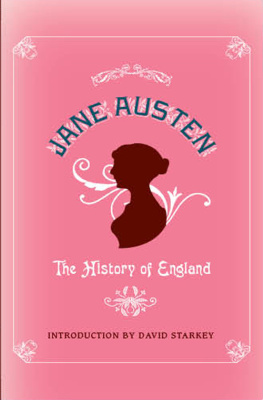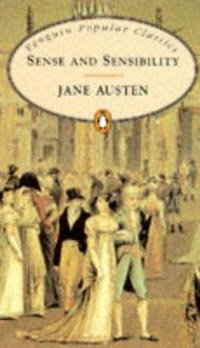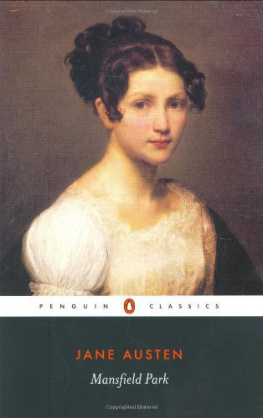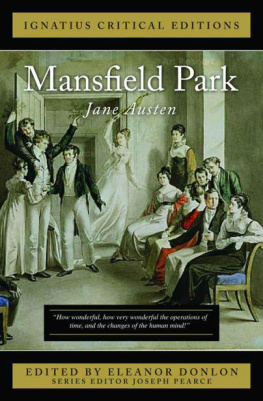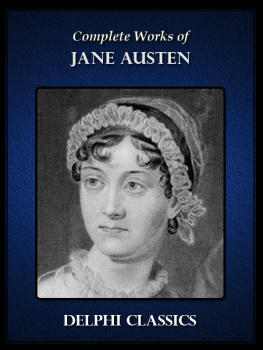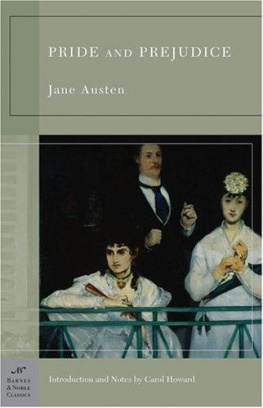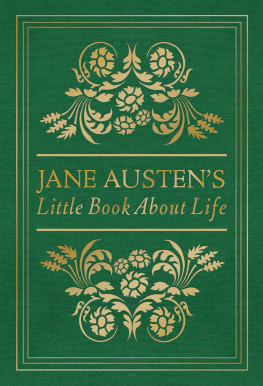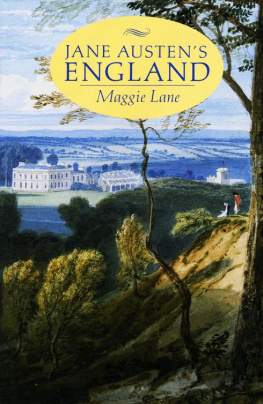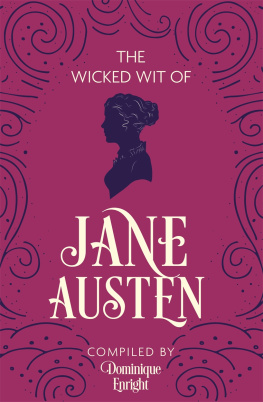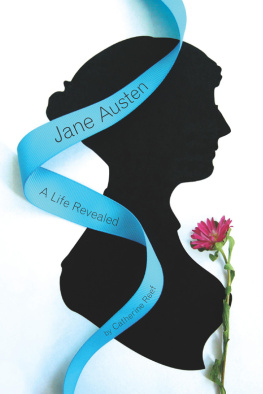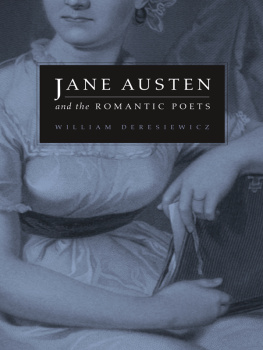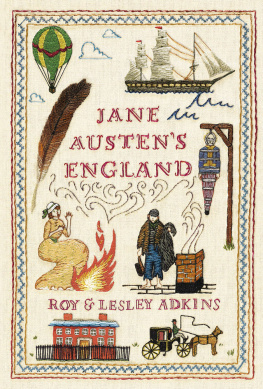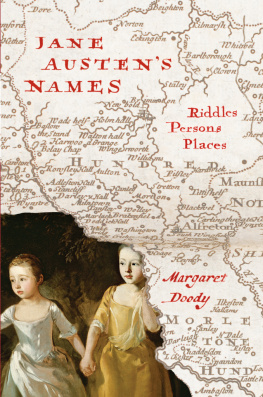Jane Austen and Charles Dickens belonged to different worlds. Austen was born into solid middle-class respectability in 1775. Her father, George, was an Oxford-educated clergyman and her mother, Cassandra (ne Leigh), the daughter of another. She grew up living a comfortable, bucolic existence in her fathers Hampshire rectory. Born in 1812, Charles Dickens also experienced an early childhood in the county of Hampshire. But his youthful idyll came to an end in 1824 when his father was thrown into gaol for debt and he found himself an apprentice in a boot-blacking factory near the Strand in London. Dickens never overcame the sense of degradation he felt after this rapid decline in social status.
Such differences in personal history go a long way towards explaining both the relative narrowness of Austens literary canvasa predilection for the marital and moral dilemmas of the rural well-to-doand Dickens ability to write about virtually the entire gamut of English society: from gentle-folk and factory owners to poor seamstresses and metropolitan pickpockets. Yet there are also similarities between them. Both are rightly esteemed as brilliant practitioners of their craft, and both dramatised human foibles with often withering satire. Moreover, Austen and Dickens did something highly unusual for either the budding or the established novelist: they wrote histories of their native land. Austens rambunctious The History of England from the Reign of Henry the 4th to the Death of Charles the 1st and an excerpt from Dickens more serious A Childs History of England are here presented together as powerful demonstrations of the way in which life experiences shape not only works of fiction but also attitudes to the past. Individually, they are also under-appreciated gems of English literature.
Austen produced her History of England in 1791 at the age of sixteen. It comprises just 34 pages of manuscript supported by thirteen watercolour miniatures of English monarchs painted by her older sister, Cassandra. Charles Dickens wrote his Childs History of England in the early 1850s when already a hugely successful novelist with an international following. His was a far more substantial work, comprising 38 detailed chapters. The first deals with Ancient England and the Romans and the last gives a highly compressed account of the 18th and 19th centuries. A Childs History was to appear on the curricula of British schoolchildren well into the 20th century; many thousands of young boys and girls first learned of Hereward the Wake, Wat Tyler, John Hampden and Oliver Cromwell from Dickens fast-paced excursion through Englands past.
In contrast, Jane Austens History of England remained unpublished until 1922. This is not surprising, for Austens history had been written for performance at home rather than publication. Although generally shy in public, as an adolescent Jane Austen entertained her family circle in the parlour of her fathers rectory by reading novels out loud and, with the help of siblings and a cousin, recreating London stage successes. She also presented her own short satirical compositions. Her History of England is one of 29 unmistakably precocious works of juvenilia written for domestic amusement. These were preserved in three slim quarto notebooks now held by the British Library in London. Comprising short stories, brief epistolary novels and fictional letters, most of these early works are social comedies. All reveal a young woman who read voraciously but with a keen and often merciless cynicism. Austens natural impulse was towards parody, and the sentimental excesses of romantic fiction offered her especially rich pickings. Thus in her short novel Lesley Castle , Austen mocked the affected generosity of young womens correspondence, as when her lead character unblushingly comments to her friend: How often have I wished that I possessed as little personal beauty as you do; that my figure was as inelegant; my face as unlovely; and my appearance as unpleasing as yours! Elsewhere the story slips into the burlesque, with absurdly named characters like Lady Kickabout.
Austen compiled her juvenilia at a time when James Gillray and Thomas Rowlandson had achieved fame for their savage caricatures of venal statesmen, physicians and lawyers. Yet few young women of her class, education and literary ability would have seen cutting satire as their mtier . Her early writings reveal that, even as an adolescent, she had the moral detachment that allowed her to perceive in the social rituals of her day so much self-serving cant and egotism. By the time she completed the earliest version of Pride and Prejudice in August 1797, she had acquired a more restrained and measured voice; but the splinter of ice in the heart that Graham Greene believed essential for the writer had made itself felt much earlier.
Austens History of England is of a piece with her early fictional works. It too is a work of deliberate and often witty parody. Each crowned head in turn is subjected to the mocking satire of a self-confessed partial, prejudiced, & ignorant Historian. Austen begins with Henry IV, who ascended to the throne after having prevailed on his cousin & predecessor Richard the 2d to resign it to him, & to retire for the rest of his Life to Pomfret Castle, where he happened to be murdered. And she continues in the same vein of comic navet . Henry VI is excoriated for no other reason than his being a Lancastrian; Richard III is described as very respectable on the grounds of belonging to the house of York; Henry VII was as great a villain as ever lived; and Henry VIIIs sole virtue was his not being quite so bad as his daughter Elizabeth, herself a pest to Society who persecuted the most amiable Mary Queen of Scots. These sketches are playful and amusing, but there is also the underlying cold-bloodedness that gives the novels of Austens maturity their steelshe blithely remarks that Lord Cobham was burnt alive, but I forget what for.
Such superficialities were for Austen a stylistic choice. Throughout her History of England Austen feigns ignorance, warning the reader at the start: N.B. There will be very few Dates in this History. She goes on to talk of Henry VIIIs amiable wife Anna Bullen and to excuse the brevity of her account of this kings reign on the grounds that It would be an affront to my Readers were I to suppose that they were not as well acquainted with the particulars of this Kings reign as I am myself. In a way that recalls Sellar and Yeatmans classic 1066 And All That , Austen delights in getting the facts twisted, muddled or plain wrong. Indeed, the parallels between these two parodies are often very close. Sellar and Yeatman had similar fun with the inability of most people to remember correctly the names of Henrys six wives: Henry VIII [had]VIII wives, memorable amongst whom are Katherine the Arrogant, Anne of Cloves, Lady Jane Austin and Anne Hathaway. Perhaps Sellar and Yeatman drew inspiration from Austens History and thus paid homage to their precursor.
And like the authors of 1066 And All That , Austens opinionated frivolousness had a point. More than whimsy, her History of England is a satire on the style of history writing and pedagogy to which young girls of her class and station were routinely subjected. Austens implicit objection was to the vapidity of history education. Names, dates and events were usually learned by rote, a passionless instruction in dry facts that were later garbled and misconstrued. In the final paragraph, Austen admits that the recital of any Events (except what I make myself) is uninteresting to me. And she exults in illustrating how little the bored student gained from lessons in English history. The few facts recalled were trivial or, like Cobhams death or the Earl of Essex putting his hand on his sword before Elizabeth I, rendered meaningless because all sense of historical context had been forgotten.

